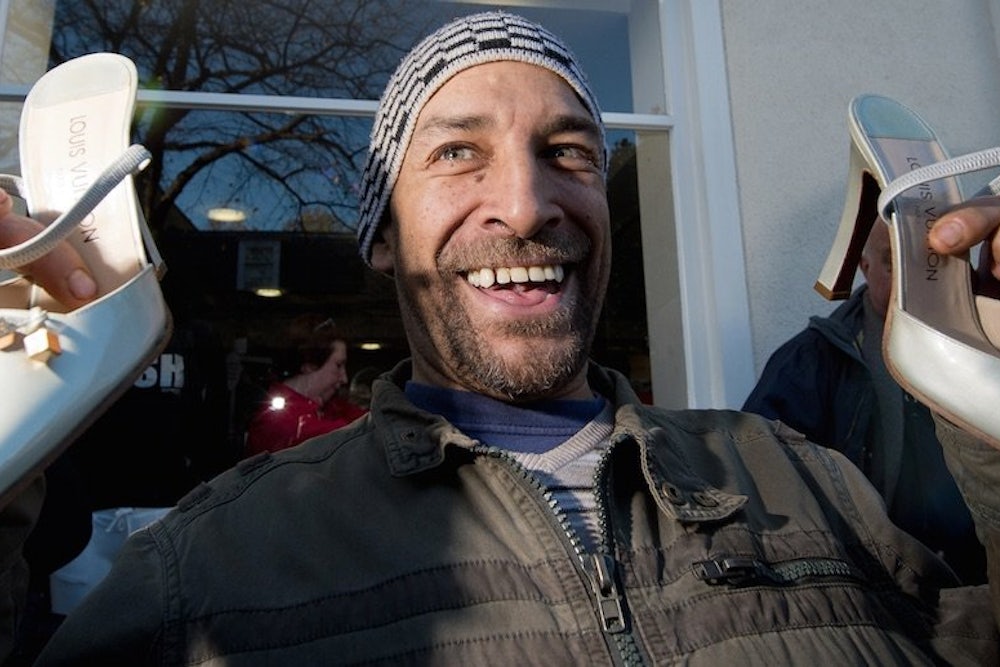It can be satisfying, if unnerving, to see one’s own personal experiences vindicated in serious research. In Pacific Standard, Tom Jacobs discusses two studies showing a relationship between high levels of income inequality and an interest in luxury goods, offering insight into—as he puts it—“the appeal of bling to the left-behind.”
The first study “found a link between lower household income, relative to one’s neighbors, and the purchase of ‘high-status cars,’ along with riskier portfolios and higher levels of debt.” The second, a psychology study, was a bit more complicated. It found that in states with higher levels of income inequality, more people Google luxurious brands—Ralph Lauren, David Yurman—and items such as furniture and shoes. In states with lower levels of income inequality, search terms like "chicken bake," "lemon bars recipe" and "chick flick movies" were more common.
Jacobs points out that the study doesn’t show that rich people aren’t among those Googling designer goods, but also that searching doesn’t mean buying:
“While the researchers have no way of knowing how many of these fur vests and designer rain boots were actually purchased, their results suggest a larger rich-poor gap prompts people to spend ‘cognitive resources and time’ searching for ways to keep up the appearance of affluence.”
According to the study, this effort to appear affluent is "at the likely expense of alternatives that may be more conducive to the health and well-being of self and society." In other words, a sense that others can afford things that you can’t has a way of imbuing the things in question with a power they wouldn’t otherwise have. Even if you don’t purchase any of the items, the mere act of looking has a cost.
As someone whose browser history would reveal a reasonable amount of time, and I suppose cognitive resources, devoted to virtual window-shopping (if also, confusingly, lemon bars), this hit home. The findings Jacobs cites overlap significantly with my own entirely unscientific musings a while back about why a certain pair of high-end yoga pants I’d been quasi-coveting somehow seemed more interesting, more special, because I couldn't afford them. If you’re rich enough, you’re automatically spared the pangs of desire for items you want but can’t or shouldn’t purchase. Such pangs of desire, in turn, get stigmatized as materialistic.
While lower-income shoppers may not be buying luxury items in droves, ever-lower clothing prices and fast fashion have made it possible to look of-the-moment on nearly any budget. So it's no surprise that trendiness is now stigmatized in favor of “investment” purchases and “slow fashion” brands. While some of this comes from a genuine (and necessary) horror at the appalling labor conditions under which much cheap clothing is produced, the fact that high-end clothing isn’t necessarily produced more ethically suggests the horror of cheapo brands has an additional source. Some other form of distinction, as Pierre Bourdieu called it, is surely in order. To say that cheap clothes are tacky would be privileged and oblivious. Instead, one can highlight the poor quality and ethical concerns. While it’s technically possible to dress ethically on a low income (thrift stores!), the only people able to do this without sacrificing fashion are, of course, the rich, who can afford to buy new “classics” each season. Perhaps it’s a feature, not a bug, of the ethical fashion movement that it’s unaffordable.
Rising income inequality might help to explain why the upscale trends of recent years—slow fashion, lentils, normcore/athleisure/whatever-we’re-calling-it-when-Vogue-writers-discover-sweatshirts—are all, at least in appearance, rejections of conspicuous consumption. To be seen wanting nice things detracts from one’s status. The class dimensions of fashionable minimalism, laid out last year by the New York Times' Anna North, are well-established: To partake in the act of stylishly not owning things, it helps to still own quite a few. To get rid of everything you don’t love, you can’t—as Lisa Miller explained in New York—have a sense of need. And to join the buy-less-experience-more brigade by jetting to the Mediterranean requires more money than you'll save by eschewing a few $5 tops at H&M.
It could be, then, that as income inequality continues to grow in America, so too will the trend of rich people appearing to live with less—while poor people actually do.
